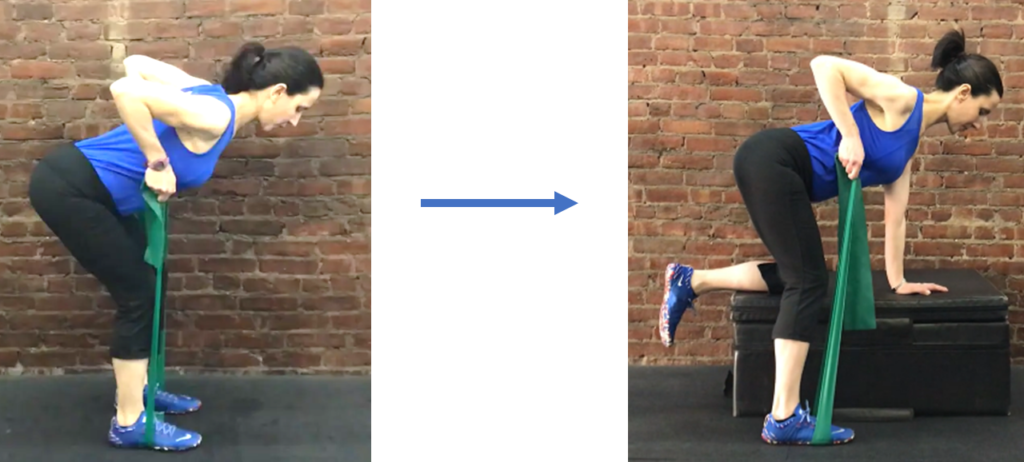Pregnancy Low Back Pain: Exercises to Focus On & Avoid

Low Back Pain (LBP) is the #1 most common discomfort during pregnancy. In fact, close to 70% of people develop LBP at some point during pregnancy (Wang et al., 2004). This is so common that it may seem inevitable. However, by understanding its causes, you will be better positioned to adjust certain habits to reduce its effects (or perhaps avoid it altogether).
Let’s first discuss why LBP is common during pregnancy. Then, we’ll cover up 7 basic exercises to help you reduce painalong with some positions and activities to avoid to make sure you don’t make the disease worse.
Why is LBP common during pregnancy?
The reason for its ubiquity is that there are several physiological and biomechanical factors that come together at about the same time, creating the conditions for LBP to develop. Here are some of the main contributors:
- Alignment Changes: One of the biggest causes of LBP is the alignment shift created from your growing belly tilting down into your pelvis, pulling your lower back into an excessive arch (as pictured below). This position compresses the tissues in the lower back, making it tight and uncomfortable.
- Shifting the Center of Gravity: The other “fun” side effect of your growing belly is actually this your center of gravity changes (which is usually 2″ below your belly button) upwards and out. When this happens, the muscles in your back have to work harder to keep you from falling. So, they are in constant tension. In addition, too much weight in the front often leads people to pay leaning back to better balance themselves (as pictured below), which can further accentuate the pressure on the lower back.


- Hormonal Changes: During pregnancy, there is an increase in the so-called hormone relaxin. As its name suggests, relaxin is responsible for softening all soft tissues in the body. The goal is to allow the pelvis to expand to accommodate the growing baby and to facilitate an easier birth. However, the down side of this pelvic loosening is a decrease in stability in this region, making it more difficult to resist the shift in the center of gravity.
- A Stressed Core: As your baby grows, your belly stretches — lengthening the many layers of your abdominal muscles. This increased length, combined with the suboptimal position of the extremely low back arch (mentioned above), makes it difficult for your core muscles to do their critical job of resisting getting into neutral alignment. As weight gain increases and alignment shifts, it can exceed the core’s capacity to handle. Furthermore, excessive low back arching reduces activation of the glutes, which are critical in providing support for the core and low back muscles. With all of these factors in play, LBP is in a position to thrive.
- Fatigue/Fatigue: This can lead to longer periods of sitting – and bending over – which puts additional pressure on the low back.
7 Focused Exercises To Relieve Pain
Now that you understand the contributing factors that can lead to LBP, it’s time to focus on the things you can do to help support your body to reduce, or prevent, the effects of LBP. Practice the 7 essential exercises below.
- Find Neutral Alignment: OK, so this first one isn’t technically an “exercise,” but it is most important tip to focus on to reduce LBP. It has to do with entering your body neutral alignment to reduce pressure on your low back. Watch the video below to learn how to keep your body neutral, and try to remember this as you go about your day — especially during long periods of standing or walking.
- 360° Breathing: The deep muscles and glutes help to stabilize the spine and pelvis. Strong core and glute muscles can help counteract alignment shifts that pull the lower back into an excessive arch. Start by mastering what we call the #1 most effective core exercise: 360° Breathing. This simple movement activates your deep core muscles and makes them work together in harmony. Practice it on its own first, then learn how to incorporate it into your moves, as discussed in the demo below.
- Cat-Cow: This is a great mobility exercise to relieve tension in the low back. However, a common mistake is to focus more on the movement upper back, which does not provide as much needed stretch to the low back. Watch the video demonstration below, which shows you how start the movement from your pelvis to increase the release in your low back.
- Quadruped T-Spine Stretch: Another factor that can cause tightness in your lower back is when adjacent parts of your body — like your hips and thoracic spine — are tight, and therefore move less than they should. When this happens, your low back often overcompensates during the movement (meaning more stress on your low back). Therefore, exercises #4 – 6 are designed to release these adjacent areas to help relieve stress from your lower back. This quadruped t-spine stretch helps to mobilize your thoracic spine.
- Kneeling Tendon Flexion Tendon: Your hip flexors are another adjacent area that can increase tension in the low back if they are tight. Therefore, this hip flexor stretch is a great way to keep your hip flexors supple to reduce tension on your low back.
- Windshield Wiper: This is a great hip mobility exercise to avoid putting too much stress on your low back.
- bridge: As mentioned in exercise #2 above, strong core and glute muscles are important for reducing low back pain. The bridge is a great exercise to strengthen your glutes, and it’s safe to do throughout pregnancy. Even if it has something to do with it lying on your backyou are moving all the time, so it is completely safe.
We hope these exercises will help you feel some relief. If your pain is severe, you may also consider seeking a prenatal certified acupuncturist or massage therapist. Having another pair of helping hands can help provide comfort to a body that’s trying to grow a little.
What to Avoid
While you focus on the above exercises to provide relief, you’ll also want to avoid those positions or conditions stir up pain, as follows:
- “Anti-Extension” Exercises: Anti-extension moves are basic exercises that involve resisting getting into extension — think planks and dead bugs. These moves can sometimes be too much for them already experiencing LBP. So, if you are experiencing pain, avoid these types of movements until you are asymptomatic.
- Moves that “ask a lot” of your core: Similar to the point above, if you experience pain, avoid movements that require a lot of core work. For example, in the left picture below, you can see the two arms bent in the row require a bit of core work to hold that position. You can change it to a kneeling row, as you can see in the picture to the right, using the other arm to support the weight of your body. This significantly reduces the load on the lower back.


- “Reduce” your weights: We mean this in two ways. First, lowering (or subtraction) the amount of weight you lift is a great strategy to relieve some of the work from your low back. In addition, you can also download the position of your weight. For example, when doing squats with a set of dumbbells, you can hold the weights at your sides, as opposed to holding them in a racked position in front of you or across your chest. As a rule of thumb, the higher you lift the weight above you, the more your core (or low back) has to work.
- Avoid Provocative Positions: This one is obvious but worth mentioning. If something hurts, don’t do it. Even if you think you have to fight the discomfort for the long-term benefits of doing some activity, don’t.
Want More Help?
For effective prenatal workouts that will help you build strength and relieve common pregnancy pains like LBP, explore our prenatal training programs. Or, for a more personalized approach, work with one of our Pronatal Personal Trainers.
Interested in Coaching Pre & Postnatal Clients?
Are you a fitness or health professional interested in working with pre and postnatal clients? Explore our Pre/Postnatal Professional Education. We offer a Specialist Course for trainers and coaches who want to specialize in this population and a Mini Course for group fitness instructors who just need the basics.
Sources:
Wang, S., Dezinno, P., Maranets, I. Berman, MR, Caldwell-Andrews, AA, Kain, ZN (2004). Low Back Pain in Pregnancy. Obstetrics and Gynecology. 104(1), 65-70.





